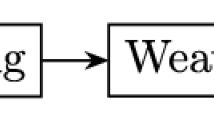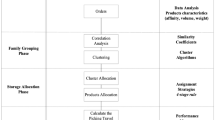Abstract
We study the combinatorial FIFO stack-up problem. In delivery industry, bins have to be stacked-up from conveyor belts onto pallets with respect to customer orders. Given k sequences \(q_1, \ldots , q_k\) of labeled bins and a positive integer p, the aim is to stack-up the bins by iteratively removing the first bin of one of the k sequences and put it onto an initially empty pallet of unbounded capacity located at one of p stack-up places. Bins with different pallet labels have to be placed on different pallets, bins with the same pallet label have to be placed on the same pallet. After all bins for a pallet have been removed from the given sequences, the corresponding stack-up place will be cleared and becomes available for a further pallet. The FIFO stack-up problem is to find a stack-up sequence such that all pallets can be build-up with the available p stack-up places. In this paper, we introduce two digraph models for the FIFO stack-up problem, namely the processing graph and the sequence graph. We show that there is a processing of some list of sequences with at most p stack-up places if and only if the sequence graph of this list has directed pathwidth at most \(p-1\). This connection implies that the FIFO stack-up problem is NP-complete in general, even if there are at most 6 bins for every pallet and that the problem can be solved in polynomial time, if the number p of stack-up places is assumed to be fixed. Further the processing graph allows us to show that the problem can be solved in polynomial time, if the number k of sequences is assumed to be fixed.









Similar content being viewed by others
References
Bodlaender HL (1993) A tourist guide through treewidth. Acta Cybern 11:1–23
Borodin A (1998) On-line computation and competitive analysis. Cambridge University Press, Cambridge
de Koster R (1994) Performance approximation of pick-to-belt orderpicking systems. Eur J Oper Res 92:558–573
Fiat A, Woeginger GJ (1998) Online algorithms: The state of the art, volume 1442 of LNCS. Springer, New York
Gurski F, Rethmann J, Wanke E (2013) Complexity of the FIFO stack-up problem. ACM computing research repository (CoRR), arXiv:1307.1915
Gurski F, Rethmann J, Wanke E (2014) Moving bins from conveyor belts onto pallets using FIFO queues. In: Proceedings of the international conference on operations research (OR 2013), Selected papers, Springer, pp 185–191
Gurski F, Rethmann J, Wanke E (2015) A practical approach for the FIFO stack-up problem. In: Modelling, computation and optimization in information systems and management sciences, Advances in intelligent systems and computing, vol 360. Springer, pp 141–152
Johnson T, Robertson N, Seymour PD, Thomas R (2001) Directed tree-width. J Comb Theory Ser B 82:138–155
Kashiwabara T, Fujisawa T (1979) NP-completeness of the problem of finding a minimum-clique-number interval graph containing a given graph as a subgraph. In: Proceedings of the international symposium on circuits and systems, pp 657–660
Kitsunai K, Kobayashi Y, Komuro K, Tamaki H, Tano T (2012) Computing directed pathwidth in \({O}(1.89^n)\) time. In: Proceedings of international workshop on parameterized and exact computation, LNCS, vol 7535. Springer, pp 182–193
Monien B, Sudborough IH (1988) Min cut is NP-complete for edge weighted trees. Theor Comput Sci 58:209–229
Papadimitriou CH (1994) Computational complexity. Addison-Wesley Publishing Company, New York
Rethmann J, Wanke E (1997) Storage controlled pile-up systems, theoretical foundations. Eur J Oper Res 103(3):515–530
Rethmann J, Wanke E (2000) On approximation algorithms for the stack-up problem. Math Methods Oper Res 51:203–233
Rethmann J, Wanke E (2001) Stack-up algorithms for palletizing at delivery industry. Eur J Oper Res 128(1):74–97
Tamaki H (2011) A polynomial time algorithm for bounded directed pathwidth. In: Proceedings of graph-theoretical concepts in computer science, LNCS, vol 6986. Springer, pp 331–342
Yam KL (ed) (2009) The Wiley encyclopedia of packaging technology. Wiley, New York
Acknowledgments
We thank Prof. Dr. Christian Ewering who shaped our interest into controlling stack-up systems. Furthermore, we are very grateful to Bertelsmann Distribution GmbH in Gütersloh, Germany, for providing the possibility to get an insight into the real problematic nature and for providing real data instances.We would also like to thank the referees for their valuable comments and suggestions, which improved the presentation of this paper.
Author information
Authors and Affiliations
Corresponding author
Additional information
A short version of this paper appeared in the Proceedings of the International Conference on Operations Research (OR 2013) (Gurski et al. 2014).
Rights and permissions
About this article
Cite this article
Gurski, F., Rethmann, J. & Wanke, E. On the complexity of the FIFO stack-up problem. Math Meth Oper Res 83, 33–52 (2016). https://doi.org/10.1007/s00186-015-0518-9
Received:
Published:
Issue Date:
DOI: https://doi.org/10.1007/s00186-015-0518-9




